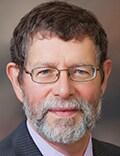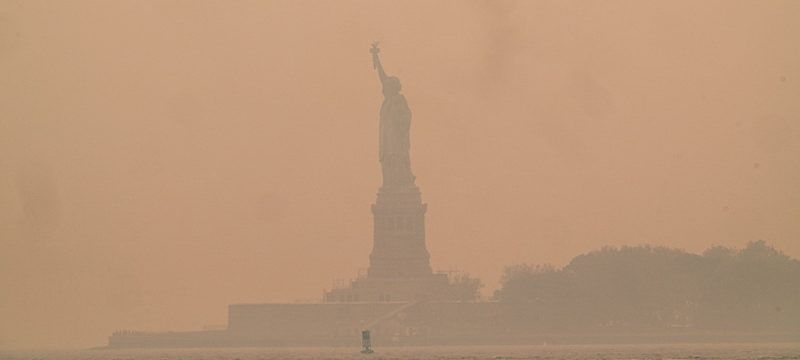Canadian wildfires that sent smoke drifting into New York City between June 6 and June 8, 2023 were associated with significant increases in emergency department (ED) visits related to asthma syndrome compared with reference periods, a study suggests.
The number of asthma syndrome ED visits, which were defined as having chief complaint mentions of asthma, wheezing, or chronic obstructive pulmonary disease (COPD), increased to 261 per day during the 3-day smoke wave compared with 181.5 per day during reference periods before (May 30 to June 1, 2023) and after (June 13 to 15, 2023) the smoke wave. Visits peaked on June 7.

Kai Chen
“Wildfire smoke is no longer a West Coast issue here in the United States,” study author Kai Chen, PhD, assistant professor of epidemiology at Yale School of Public Health in New Haven, Connecticut, told Medscape Medical News. “In fact, we have seen evidence that the US air quality, on average, is becoming worse due to the increased wildfire smoke air pollution.”
The study was published as a research letter on September 21 in JAMA.
All Boroughs Affected
The researchers used New York’s syndromic surveillance system to collect data on deidentified asthma syndrome visits at all 53 EDs in the city during the smoke wave and the reference periods. They compared this information with data on ambient fine particulate matter (PM2.5) concentrations, which were obtained from 10 local US Environmental Protection Agency monitoring stations. During the smoke wave, daily mean PM2.5 levels reached 100.9 μg/m3 compared with the reference period levels of 9.0 μg/m3.
The number of asthma syndrome ED visits was 783 during the smoke wave compared with 523 and 566 in the reference periods before and after the wave, respectively (incidence rate ratio [IRR], 1.44). The significant increase during the smoke wave was observed in patients of all ages. It was most pronounced in patients aged 18-64 years (IRR, 1.52), followed by patients aged 5-17 years (IRR, 1.32), those aged 65 years or older (IRR, 1.24), and those aged 4 years or younger (IRR, 1.12).
All boroughs of the city reported an increase in asthma syndrome ED visits during the smoke wave. Staten Island had the most acute impact (IRR, 2.63), followed by Queens (IRR, 1.62), Manhattan (IRR, 1.45), Bronx (IRR, 1.42), and Brooklyn (IRR, 1.35).
A news article published alongside this research cited several other studies that suggested that “wildfire-specific PM2.5 may be especially toxic” compared with other PM2.5.
Although the current researchers did not analyze the composition of the wildfire smoke, Chen agreed with this hypothesis. “In addition to wood burning, some wildfires burning homes, cars, and facilities can generate a lot of toxic pollutants such as carcinogenic organic compounds,” he told Medscape Medical News.
“This summer, we have seen firsthand evidence of extreme weather events happening across the world, including those that traditionally would have been unthinkable,” said Chen. “Having an orange sky in New York due to the Canadian wildfire smoke is such an ‘unthinkable’ event,” he added. “With the hottest summer on record, unfortunately, this type of extreme event is happening and will be more [frequent] and more intense in the future.”
Previous Findings Similar
Commenting on the findings for Medscape Medical News, George D. Thurston, ScD, professor of medicine and population health at New York University School of Medicine, said, “The JAMA study’s overall effect estimate is quite comparable with our reported finding of RR = 1.03 increased risk per 10 μg/m3 wildfire PM2.5 mass.” His group’s study was published in August. He did not participate in the current research.
To analyze PM2.5 levels in New York on June 7, 2023, Thurston’s group used a different statistical approach from that of the current researchers. “We normalized our results as a per 10 μg/m3 so as to allow more direct comparisons with risks reported by other studies of wildfire and more usual particulate matter exposure effects,” he said.
In addition, his group separated out the effect of “background” PM2.5 vs that of wildfire-specific PM2.5 and analyzed the elemental composition of the smoke. They showed that while “the percentage of oxidative stress-inducing metals is much lower in the wildfire PM2.5…In contrast, potassium, an element usually enriched in biomass combustion particles, has a 51% higher content per unit mass than usual New York PM2.5.”

John Balmes, MD
“There is now strong evidence that wildfire smoke can exacerbate asthma, but virtually all previous studies have been conducted in wildfire-prone areas,” said John Balmes, MD, professor emeritus of environmental health sciences at the University of California, Berkeley. “What is new about the reports of increased asthma healthcare utilization in New York during the poor air quality from the Canadian wildfires is the impact on areas many hundreds of miles from the source of the smoke.” Balmes did not participate in the research.
“As a pulmonary and critical care physician, I never like when people suffer exacerbations of asthma, COPD, and other respiratory illnesses. That said, a silver lining of the bad air quality due to wildfire smoke in the East Coast and Midwest during June is that it should serve as a wake-up call to those who thought wildfires were only a problem in the Mountain West. Hopefully, this recent taste of bad air will spur people to action to mitigate the climate change emergency that we all face together.”
The study authors reported no funding. One of Chen’s coauthors received grants from the National Institutes of Health (NIH), the Environmental Protection Agency (EPA), HEI, the Wellcome Trust, the Robert Wood Johnson Foundation, Yale Women Faculty Forum, and the High Tide Foundation. She also receives honoraria from NIH, Clinique, the Government of Hong Kong Special Administrative Region–Food and Health Bureau, Colorado School of Public Health, PAC-12, IOP, and Fund for Scientific Research–FNRS outside the submitted work. The same author has received travel reimbursement from the Colorado School of Public Health and is a member of EPA Clean Air Scientific Advisory Council and various National Academies committees. Thurston reported no relevant disclosures. Balmes is the physician member of the California Air Resources Board.
JAMA. Published September 21, 2023. Full text
Kate Johnson is a Montreal-based freelance medical journalist who has been writing for more than 30 years about all areas of medicine.
For more news, follow Medscape on Facebook, X, Instagram, and YouTube
Source: Read Full Article
